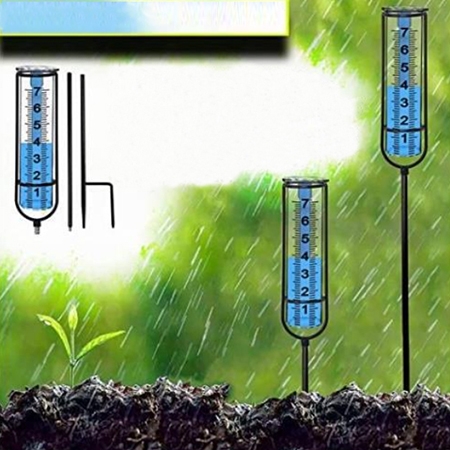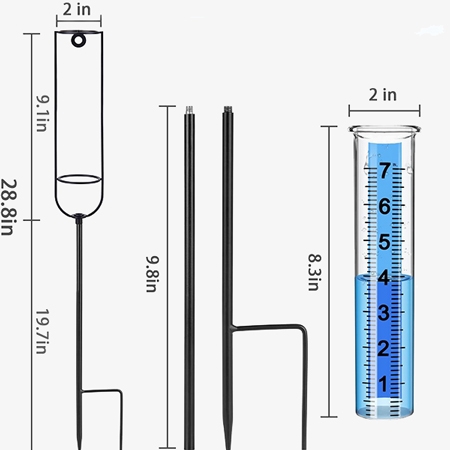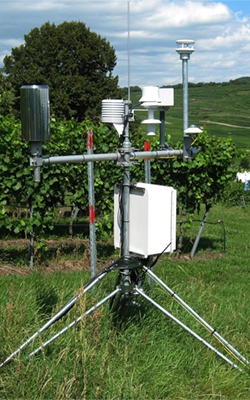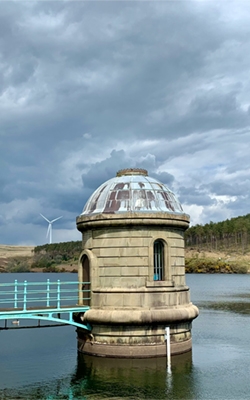SISCO precision outdoor rain gauge's stakes is designed as H-shape to secure in the ground, rust-proof and upright.Which make the rain gauge for fence more stable and no fear about strong wind. The rain gauge is suitable for all types of landscapes, and is easily placed, including clay, dirt, topsoil, grass, sand etc.

Add a Color Strip Behind the Rain Gauge for Easier Reading
- Upgraded Large-Font Scale: The scale on the glass rain gauge tube features enlarged, easy-to-read markings, divided into ten equal parts per inch for higher precision.
- Improved Accuracy and Visibility: Finer scale divisions and larger numbers enhance measurement accuracy and make rainfall readings clearer and more user-friendly.
- Colored Metal Strip for Contrast: A colored metal strip is added to the back of the tube, turning the water blue and significantly improving the visibility of the water level.
- Anti-Reflection Design for Easy Reading: This thoughtful design helps eliminate issues caused by light reflection or water transparency, making the rain gauge easier to read at a glance.

The Outdoor Rain Gauge has a Design of 3-Sections Adjustable Height
- Three-Section Design: The rain gauge features a detachable three-section structure, allowing for flexible assembly and disassembly depending on your usage needs.
- Maximum Height of 29 Inches: When fully assembled, the rain gauge stands tall at 29 inches, providing greater visibility and reducing splash interference for more accurate readings.
- Adjustable to 19 Inches: The middle section can be removed, reducing the height to 19 inches - ideal for garden beds, raised planters, or areas with limited vertical space.
- Meets Multiple Placement Needs: Whether used in a yard, farm, or patio, this adjustable-height design ensures stable placement and user convenience across various outdoor environments.
Dimension

Applications
The SISCO rain gauges are widely used in hydropower stations, reservoirs, agriculture and forestry, meteorological stations, and hydrological stations to accurately measure rainfall for weather observation, irrigation planning, and water resource management.

Reservoir

Weather Station

Hydrological Station

Agriculture and Forestry
| Model | SISCO-RG-glass |
| Measuring Tube Material | High-quality glass |
| Scale Graduation | 1 mm increments |
| Tube Diameter | 2 inches |
| Tube Length | 9.1 inches |
| Installation Type | Ground stake /fence mount / garden spike |
| Temperature Resistance | -10°C to 50°C (14°F to 122°F); avoid freezing water inside the tube |
| Weather Resistance | UV-resistant, rustproof holder; waterproof and corrosion-resistant parts |
| Dimensions | 28.8 inches (including stand/frame) |
| Weight | 300g |
Q1: What is a rain gauge?
A1: A rain gauge is a meteorological instrument designed to accurately measure the amount of rainfall over a set period, usually recorded in millimeters or inches. It collects rainwater in a funnel or container, allowing for precise quantification of precipitation, which is vital for weather forecasting, agricultural planning, water resource management, and environmental research. There are several types of rain gauges, including manual gauges that require periodic reading, tipping bucket gauges that automatically record rainfall by counting bucket tips, weighing gauges that measure the weight of collected water, and advanced optical or radar-based gauges that estimate rainfall remotely.
Q2: Why a rain gauge is important?
A2: A rain gauge is important because it provides accurate and reliable measurements of rainfall, which are essential for weather forecasting, managing water resources, agriculture, and flood prevention. By tracking precipitation levels, rain gauges help farmers optimize irrigation, enable meteorologists to predict storms and droughts, support water authorities in managing reservoirs and flood control, and contribute to climate research and environmental monitoring. Without precise rainfall data, it would be much harder to make informed decisions that protect communities and sustain ecosystems.
Q3: Can a rain gauge be any size?
A3: A rain gauge can come in various sizes, but its dimensions must be carefully designed to ensure accurate and reliable measurements. Larger gauges can collect more rainwater and are often used in professional or research settings, while smaller, more portable gauges are convenient for personal or educational use. However, the size of the collection area affects the sensitivity and precision of the readings, so rain gauges are typically designed following standard dimensions to balance ease of use with measurement accuracy.
Tips: Is the glass rain gauge durable enough for outdoor use?
Yes, the glass tube in an outdoor rain gauge is generally durable enough for outdoor use. It is typically made from thick, weather-resistant or tempered glass designed to withstand rain, sun exposure, and temperature changes. However, care should be taken in freezing conditions—if water inside the tube freezes and expands, it may cause the glass to crack. To prolong its lifespan, it's recommended to empty or remove the tube during winter months in colder climates. With proper handling and periodic maintenance, a glass rain gauge can last for many years outdoors.
Thank you for buying industrial test and measurement equipment on SISCO.com, all products sold by SISCO and the partner cover a 12 months warranty, effective from the date of receiving the products.
What is covered?
SISCO is responsible for providing free spare parts, and free technical support to assist the customer to repair the defective products until the problem is solved.
What is not covered?
- Product purchased from anyone other than a SISCO store or a SISCO authorized reseller.
- Expendable parts.
- Routine cleaning or normal cosmetic and mechanical wear.
- Damage from misuse, abuse or neglect.
- Damage from use of parts other than SISCO approved.
- Damage from use outside the product’s usage or storage parameters.
- Damage from use of parts not sold by SISCO.
- Damage from modification or incorporation into other products.
- Damage from repair or replacement of warranted parts by a service provider other than a SISCO authorized service provider.
- Damage caused by the application environment not meeting the product usage requirements and the failure to perform preventive maintenance.

